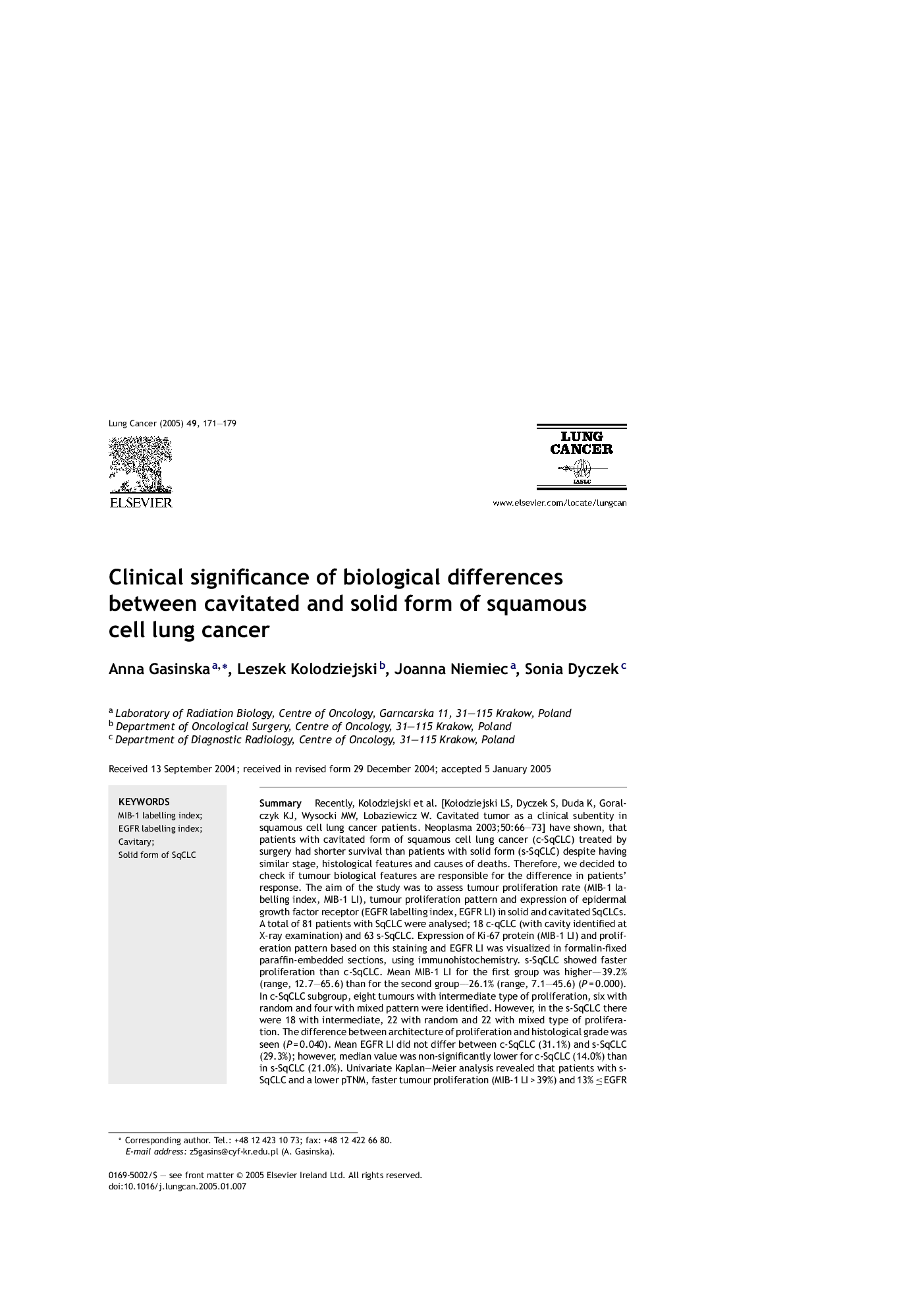| کد مقاله | کد نشریه | سال انتشار | مقاله انگلیسی | نسخه تمام متن |
|---|---|---|---|---|
| 10912038 | 1088405 | 2005 | 9 صفحه PDF | دانلود رایگان |
عنوان انگلیسی مقاله ISI
Clinical significance of biological differences between cavitated and solid form of squamous cell lung cancer
دانلود مقاله + سفارش ترجمه
دانلود مقاله ISI انگلیسی
رایگان برای ایرانیان
کلمات کلیدی
موضوعات مرتبط
علوم زیستی و بیوفناوری
بیوشیمی، ژنتیک و زیست شناسی مولکولی
تحقیقات سرطان
پیش نمایش صفحه اول مقاله

چکیده انگلیسی
Recently, Kolodziejski et al. [KoÅodziejski LS, Dyczek S, Duda K, Goralczyk KJ, Wysocki MW, Lobaziewicz W. Cavitated tumor as a clinical subentity in squamous cell lung cancer patients. Neoplasma 2003;50:66-73] have shown, that patients with cavitated form of squamous cell lung cancer (c-SqCLC) treated by surgery had shorter survival than patients with solid form (s-SqCLC) despite having similar stage, histological features and causes of deaths. Therefore, we decided to check if tumour biological features are responsible for the difference in patients' response. The aim of the study was to assess tumour proliferation rate (MIB-1 labelling index, MIB-1 LI), tumour proliferation pattern and expression of epidermal growth factor receptor (EGFR labelling index, EGFR LI) in solid and cavitated SqCLCs. A total of 81 patients with SqCLC were analysed; 18 c-qCLC (with cavity identified at X-ray examination) and 63 s-SqCLC. Expression of Ki-67 protein (MIB-1 LI) and proliferation pattern based on this staining and EGFR LI was visualized in formalin-fixed paraffin-embedded sections, using immunohistochemistry. s-SqCLC showed faster proliferation than c-SqCLC. Mean MIB-1 LI for the first group was higher-39.2% (range, 12.7-65.6) than for the second group-26.1% (range, 7.1-45.6) (P = 0.000). In c-SqCLC subgroup, eight tumours with intermediate type of proliferation, six with random and four with mixed pattern were identified. However, in the s-SqCLC there were 18 with intermediate, 22 with random and 22 with mixed type of proliferation. The difference between architecture of proliferation and histological grade was seen (P = 0.040). Mean EGFR LI did not differ between c-SqCLC (31.1%) and s-SqCLC (29.3%); however, median value was non-significantly lower for c-SqCLC (14.0%) than in s-SqCLC (21.0%). Univariate Kaplan-Meier analysis revealed that patients with s-SqCLC and a lower pTNM, faster tumour proliferation (MIB-1 LI > 39%) and 13% â¤Â EGFR LI < 80% had significantly longer survival. Cox multivariate analysis performed for the whole analysed group showed that proliferation rate, expression of EGF receptor (EGFR LI); pTNM and form of SqCLC were significant in respect of patients' survival. However, when the analysis was performed separately for s-SqCLC and c-SqCLC it appeared that biological parameters (EGFR LI and proliferation pattern) were significant only for solid and not for cavitated SqCLC form. For the latter, only clinical (TNM) and pathological stage (pTNM) appeared to be important and therefore adjuvant systemic chemotherapy after surgery may be more indicated.
ناشر
Database: Elsevier - ScienceDirect (ساینس دایرکت)
Journal: Lung Cancer - Volume 49, Issue 2, August 2005, Pages 171-179
Journal: Lung Cancer - Volume 49, Issue 2, August 2005, Pages 171-179
نویسندگان
Anna Gasinska, Leszek Kolodziejski, Joanna Niemiec, Sonia Dyczek,